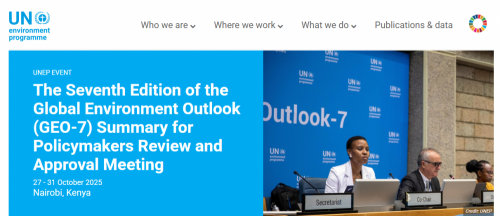
https://www.unep.org/geo/global-environment-outlook-7
The Global Environment Outlook (GEO) is the flagship report of the United Nations Environment Programme (UNEP) providing an integrated assessment of environmental change, the current state of the environment, the effectiveness of policy response and the options for achieving different possible futures in the medium to long term. As requested by Member States in Resolution EA.5/3, UNEP is working on the preparation of the seventh edition of the GEO (GEO-7) assessment and its accompanying Summary for Policymakers (SPM), to be launched at UNEA-7 in December 2025.
The GEO-7 SPM review and approval meeting, which will be held from Monday, 27 October to Friday, 31 October 2025 in-person at the United Nations Office at Nairobi.
As has been the case for previous meetings of this kind, Member States are invited to strongly consider the participation of representatives from their capitals at the meeting. In accordance with the Environment Assembly decision 6/7, Member States are encouraged to support gender balance in the composition of delegations to intergovernmental meetings such as this one.
About GEO-7
Following a very successful UN Environment Assembly, the resolution on the future of the Global Environment Outlook (GEO) was approved by Member States on 2 March, 2022. The seventh edition of GEO (GEO-7) preparations began with the inaugural meetings of GEO-7, which are the ad hoc open-ended meeting of the Assessment Procedures and Supporting Functions of the GEO meeting and the second ad hoc open-ended meeting of GEO-7. This procedures meeting was held on 19-22 September 2022. Experts nominated by Member States and UNEP-accredited stakeholders attended the ad hoc open-ended meetings of the seventh Global Environment Outlook. The second ad hoc open-ended meeting of the seventh Global Environment Outlook was held on 17-20 October 2022 in a hybrid format. This meeting reviewed and adopted the draft scoping document of GEO-7. The meeting also convened expert dialogues on food, energy and waste systems identified in GEO-6 as requiring transformation. The outcomes of these two meetings were presented at a side event titled "Progress and Outcomes of Global Environment Outlook (GEO-7) Inaugural Meetings," hosted by the 9th Annual Subcommittee Meeting of UNEP's Committee of Permanent Representatives.
GEO-7 proposes to build on key findings from GEO-6 and those of other significant assessments, which are:
- Current policies cannot keep pace with the rate of environmental degradation we face today.
- With current policies, none of the environmental Sustainable Development Goals (SDGs) will be achieved, and none of the leading internationally agreed environmental goals (e.g., the Paris Agreement, Aichi Targets, etc.) will be completed.
- Because of this, we face a triple planetary crisis of climate change, biodiversity loss and pollution.
- Policies which address the systems that are the root cause of environmental degradation should contribute to the transformational change needed to achieve an environmentally sustainable world by 2050.
- In this timeframe, the transformation of three interdependent systems—energy, food, and waste—as well as their supporting economic and financial systems is critical.
- By transforming these systems, we should contribute significantly to creating a world with a stable climate that is nature-rich (biodiverse) and that produces near-zero waste (circular) for current and future generations.
GEO-7 will also continue to assess the state and trends of the global environment, the implications for human well-being, and the achievement of the SDGs, as well as provide an outlook that provides useful guidance on the possible environmental and socio-economic consequences of the transformational changes needed. This will ensure continuity with previous GEOs and allow GEO-7 to provide some updates on the environmental impact of the global pandemic and recent disasters and conflicts. For the outlook, GEO-7 may be able to provide modelling and scenario analysis of the socio-economic effects (both positive and negative) of different solution pathways. This analysis will provide additional rationale for Member States to implement the proposed solutions pathways.









